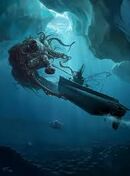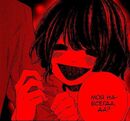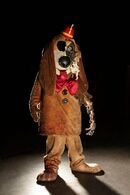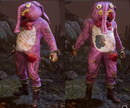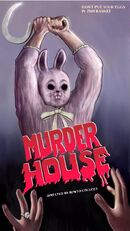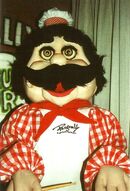Reason for Warning: This aesthetic has potential to touch on dark subject matter, including real-world murder and acts of violence. If this bothers you or could result in mental strain, please consider reading a different page.
Horror is a genre of speculative fiction that is intended to frighten, scare, disgust, or startle its readers by inducing feelings of horror and terror. Literary historian J. A. Cuddon defined the horror story as "a piece of fiction in prose of variable length which shocks, or even frightens the reader, or perhaps induces a feeling of repulsion or loathing". It creates an eerie and frightening atmosphere. Horror is frequently supernatural, though it might be non-supernatural. Often the central menace of a work of horror fiction can be interpreted as a metaphor for the larger fears of a society.
As the entire point of Horror is to frighten the audience, Horror is often considered an extremely personal and diverse genre, as it depends on the fears and distastes of the viewer. There are many subgenres of Horror that focus in specific aesthetics and styles, including but not limited to Analog Horror, B-Movie Horror, Catholic Horror, Digital Horror, Gross-Out Horror, etc.
Visuals[]
Horror aesthetic visuals are designed to achieve some sort of element of discomfort, fear, disgust, or any sort of imagery that can trigger the "fight or flight" response people naturally have. This differs from the Halloween visual aesthetic because Halloween imagery tends to be sillier with its handling of macabre imagery, thus not being taken as seriously as it could when it's played straight in the Horror aesthetic.
Fashion[]
- Graphic T-shirts
- Hoodies/Jackets
- Thigh-High socks
- Fishnet stockings
- Boots, sneakers, or any shoe you see fit
- Bodycon dresses & skirts
- Knee-high socks
- Masks
- Fake blood
- Heavy makeup
- Distressed Shorts & Jeans
- Pleated skirts
- Any dark clothing
- Striped shirts (long sleeve or short sleeve)
- Oversized sweaters
- Chokers (optional)
- Chains, buckles, and harnesses
Media[]
Literature
Horror has had a rich tradition of existence dating back to the beginning of the written word, but writers such as Edgar Allen Poe, Bram Stoker, Mary Shelley, and H.P. Lovecraft have used this fear to craft rich literary works that chilled us to the core even before the invention of film. They expertly strung together words to paint dark, macabre imagery for the reader to envision in their heads, whether it was a small, personal scale descent into psychosis or having the entire vast, uncaring nature of the universe exposed to you all at once and driving you absolutely mad in the process.
Movies[]
Horror films are films that seek to elicit fear for entertainment purposes. Initially inspired by literature from authors like Edgar Allan Poe, Bram Stoker, and Mary Shelley, horror has existed as a film genre for more than a century. The macabre and the supernatural are frequent themes. Horror may also overlap with the fantasy, supernatural fiction, and thriller genres.
Horror films often aim to evoke viewers' nightmares, fears, revulsion, and terror of the unknown. Plots within the horror genre often involve the intrusion of an evil force, event, or personage into the everyday world. Prevalent elements include ghosts, extraterrestrials, vampires, werewolves, demons, Satanism, evil clowns, gore, torture, vicious animals, evil witches, monsters, giant monsters, zombies, cannibalism, psychopaths; natural, ecological, or man-made disasters, and serial killers.
Video Games[]
- Dead by Daylight
- Silent Hill Series
- Amnesia Series
- Outlast Series
- Resident Evil Series
- Until Dawn
- The Evil Within Duology
- Observer
- Slenderman: The Eight Pages
- Friday the 13th
- Visage
- Darkwood
- Five Nights at Freddy's Series
- Phasmophobia
- Doll Eye
- Bendy Duology
- Poppy Playtime
- Dark Deception
- Granny
- Slendrina The Cellar
- The Walking Dead
- Piggy (Roblox)
- Rainbow Friends (Roblox)
- DOORS (Roblox)
- OMORI
- Yume Nikki
- Amanda the Adventurer
- Garten of Banban
- Doki Doki Literature Club!
- Spooky's Jump Scare Mansion
Music[]
Horrorcore[]
Horrorcore is a subgenre of Hip-Hop music based on horror-themed and often darkly transgressive lyrical content and imagery. Its origins derived from certain hardcore hip-hop and gangster rap artists, such as the Ghetto Boys, which began to incorporate supernatural, occult, or psychological horror themes into their lyrics.
Horror Punk[]
Horror Punk, also associated with Deathrock, is a genre that mixes punk rock 1950s-influenced doo-wop and rockabilly sounds with morbid and violent imagery and lyrics which are often influenced by horror films and science fiction B-movies, literature and art. The music is also often accompanied by lyrics that explore themes of death, fear, and the supernatural. It was pioneered by the Misfits in the late 1970s and early 1980s.
Other music[]
Outside of that, a lot of Horror music is mostly tense and orchestral by design, with some examples of it bleeding into the world of Rock and Metal. A lot of horror metal music will delve more into the realm of True Crime or the horrors of war, though some horror-based metal will draw upon classic works of horror literature or film, such as the band Ice Nine Kills.
Subgenres[]
Psychological Horror[]
Psychological Horror is a sub genre of horror and psychological fiction with a particular focus on mental, emotional, and psychological states to frighten, disturb, or unsettle its audience. Psychological horror usually aims to create discomfort or dread by exposing common or universal psychological and emotional vulnerabilities/fears and revealing the darker parts of the human psyche that most people may repress or deny. This idea is referred to in analytical psychology as the archetypal shadow characteristics: suspicion, distrust, self-doubt, and paranoia of others, themselves, and the world.
The genre sometimes seeks to challenge or confuse the audience's grasp of the narrative or plot by focusing on characters who are themselves unsure of or doubting their own perceptions of reality or questioning their own sanity. Characters' perceptions of their surroundings or situations may indeed be distorted or subject to delusions, outside manipulation or gas lighting by other characters; emotional disturbances or trauma; and even hallucinations or mental disorders.
Slasher[]
The Slasher is dedicated to all of the Slasher movie idols that have been appearing in film since the 1970s exploitation cinema era. While some Slashers predate the era (namely Leatherface from The Texas Chainsaw Massacre and Michael Myers from the Halloween films), most of the Slasher icons came about from the 1980s, no doubt inspired by the Reagan era of politics. Characters such as Freddy Krueger, Jason Voorhees, and Chucky came about from this period, but examples of modern Slasher icons include Ghostface (from the Scream series), John "Jigsaw" Kramer (from Saw series), and Art the Clown (from Terrifier series).
Universal Monster[]
The Universal Monster is dedicated to the horror films released from 1925 (back in the Silent Film era) all the way into the 1950s that frightened audiences of the time but nowadays is largely seen as kitschy and silly (which this shift began in the late 1940s). It is named the "Universal Monster" aesthetic because Universal Studios were the ones who released these classic movies, though there was an attempt to modernize the concept for the modern era with the "Dark Universe" (starting with 2014's Dracula Untold) which was an attempt to use the Universal Movie Monsters to create something similar to the Marvel Cinematic Universe.
Lovecraftian/Cosmic Horror[]
Lovecraftian is a subgenre of horror fiction that emphasizes the cosmic horror of the unknown more than gore or shock. It is named after American author H. P. Lovecraft. Cosmic horror is defined as a horror story designed to highlight just how small and insignificant we humans are in the grand scheme of the universe. The most iconic figure of Lovecraftian horror is Cthulhu. For more information of Lovecraftian horror, please check out The H.P. Lovecraft Wiki.
Satanic Panic[]
Under Construction
Survival Horror[]
Under Construction
True Crime[]
True Crime Horror has a strong focus on real-world crimes committed, with a strong focus on murder (especially serial killers). This particular aspect of the Horror aesthetic can be particularly controversial because it leads to some individuals glorifying actual murderers like Ted Bundy, Eric Harris & Dylan Klebold (the perpetrators of the infamous Columbine shootings), and Elliot Rodgers.
Mascot Horror[]
Mascot Horror is focused around the idea of taking children's mascots and subverting the initial purpose of them by turning them into killers, either tragic or not. The concept has been around for many years in other media forms (although disjointed, when it comes use the genre's later recognized non-gameplay and narrative elements) like the Child's Play series. But the most popular example and the clear starter and codifier of this in action on a video game form is the Five Nights at Freddy's and Bendy franchises. and lesser known examples like Choo-Choo Charles and My Friendly Neighborhood.
Creepypasta[]
Creepypastas are a type of copypasta, a large block of text that gets copy and pasted around the web. Copypastas usually focus on being funny, while creepypastas focus on being creepy, hence the name. A lot of them are written to be a believable folk tale or urban legend, ranging from slasher like murders and creatures to even lost and/or haunted video games and TV shows.
Comedy Horror[]
Comedy Horror entwines horror and comedy to create a situation where viewers are able to laugh at their fears while also experiencing terror, with examples like The Evil Dead: Army of Darkness, Beetlejuice, etc.
Catholic Horror[]
Main article: Catholic Horror
Analog Horror[]
Main article: Analog Horror
B-Movie Horror[]
Main article: B-Movie Horror
Digital Horror[]
Main article: Digital Horror
Gross-Out Horror[]
Main article: Gross-Out Horror
Horror Academia[]
Main article: Horror Academia
Medical Horror[]
Under Construction
Mascot Slasher[]
Mascot Slasher is a subgenre of horror that combines Mascot Horror and Slasher elements. It gained popularity in the late 2010s and early 2020s (or retroactively even earlier in the late 1980s or 1990s). Most works in this subgenre tend to be themed after fictional characters in the public domain popular with children as a primary inspiration, with the general premise involving a slasher villain that happens to be a entertainment mascot or a multi-group of mascots utilizing slasher tropes. The term also applies to works (especially those in the aforementioned Slasher subgenre) who happen to embody the trappings of a Mascot Horror work, whether it be through characters and/or marketing. Examples include Child's Play (series; could be a first prototype), Winnie the Pooh: Blood and Honey, Banana Splits (film), and Mickey's Mouse Trap (upcoming film).
Resources[]
External links to help get a better understanding of this aesthetic.

